Cultural Debates in the Nation of Quebec : Danville to Richmond
We headed out of Danville around 7:30 am on another brisk morning. The town's many church steeples were silhouetted against a pale pink and yellow sky, and the sun's early rays were setting the fall colours ablaze on the ridges rising up around the town. Behind the patch of clear sky and sunshine a very solid, dark grey cloud hung. Silhouetted against its dark banks we could see tens of thousands of Snow Geese forming a continuous shifting stream of white dots that stretched from one horizon to another. It was an awesome sight, and several well-dressed people on the sidewalk had stopped in their tracks to watch the spectacle.
As we made our way down through the town we stopped to enjoy some of the colourful sidewalk art that had been painted throughout, and to investigate a beautiful mural showing a pastoral landscape from the surrounding region. The town has many unique homes and buildings, but one of the most interesting was an octagonal brick house with a collection of concrete sculptures, statues, and fountains outside that seemed to represent various religions. This would have been an amazing town to have spent more time, but the seasons are now racing and so we must now push on.
Unfortunately, despite our best attempts to find a cafe or get breakfast none of the local shops were yet open – Gorp Bars it would be this morning.
We rejoined the trail in the large green space filled with trees, picnic tables, interpretive historical plaques, and a stone memorial. At one end was a CP railway carriage and a large restored train station that served as a Halte Velo, a café in summer, and a Tourism Information Centre. Sean was delighted to discover that the centre was partially open, and quick to collect a few tourism pamphlets that were available in English - a rare and treasured find! Here I should admit that Sean has long had a bizarre weakness for travel centres and information. In years past he has spent entire evenings pouring over regions we have never travelled, learning and dreaming up itineraries. Those that travelled the Caminos around us are familiar with the large packets of travel information and books he collected and purchased en route to Santiago - transforming his 22 lb backpack in Saint Jean Pied de Port into a 54 lb behemoth by the time he picked up his compostella. So too has he followed this trend as we have crossed Canada, leading him to mail packages of information to my parents in BC for "future reading" and for "help writing later on".
Shortly after leaving Danville on the treed cycling trail we came to signs for the turnoff to Asbestos. The name of this town has recently been changed to 'Val-des-Sources' or 'Valley-of-the-Springs' due to the negative connotations associated with asbestos. It was once home to the Jeffrey Mine, which was the world's largest asbestos mine, as well as the Magnola magnesium refinery, but both are now closed.
We continued onward, the sugar maple covered hills rising rather steeply beside the trail. The forests were all posted with 'Hunting, fishing, and trapping with permission only' signs, as well as 'No ATV' signs. In the last day, since just before Danville, we've seen signs of ATV tracks on the trail, and despite there being multiple 'No ATV' signs posted at the road crossings, the gates have been open and tied back. Interestingly, we haven't encountered any actual ATVs, and although countless tire tracks are visible. Surprisingly despite clearly being regularly used by motorized vehicles there appears to be no damage to the trail bed itself, unlike in other areas of the country where ATV use on the trail is heavy and trail conditions suffer. However, here much like Newfoundland the culture of respectful driving and trail maintenance seems to be strong and widely upheld by the various types of users on these pathways!
Walking between the forested valley walls felt like we were in a secluded and sheltered world of our own, removed from the sights, sounds, and smells of the modern world. Except for the sounds of water trickling in the stream beside us, the land around us was almost silent.
As we walked on the flat, smooth cycling trail that cut straight through the valley on the former railway line, a gentle rain began to fall. Even though it was overcast and cloudy, the morning felt like it was warming up, and as we walked we passed through slightly disconcerting bands of cold and warm air. Recently it has felt like autumn is trying to fade into winter, but the persistently warm temperatures have animals, plants, and humans caught in a pattern of uneasy waiting and expectation. It is as if we can feel climate change taking hold, but as yet we don't instinctively know how to adapt.
At first we felt like we were completely isolated and alone in the sheltered valley, but we soon realized we had lots of company. A tiny vole dashed across the trail before diving into a rounded grassy tunnel. A flock of White-throated Sparrows hopped busily around in the shrubs at the trail's edge, and a very vocal group of Blue Jays flew purposefully among the hay bales in a nearby field. A short distance later we startled two White-tailed Deer, who took off in great leaps and bounds through the tall grass. Two Red-tailed Hawks circled above the ridge, and the loud, dry, haunting calls of a pair of American Crows rang out across the valley.
When we reached the crossroads at St Cyr we took a break at La Cantonnière Halte, which was a well treed rest spot that had several picnic tables and a roofed gazebo where we took shelter from the brief drizzle. Here we enjoyed the last of our waffles and strawberry jam from the bakery in Warwick, and took a moment to relax in our peaceful surroundings, enjoying the fresh air brought on by the rain.
As we sat chatting and enjoying our treats however two cyclists who had also stopped to have a snack, marched up and soundly informed us - en francais - that if we wished to "travel through the nation of Quebec [we] had best converse in French as English was offensive to those who live here." After informing us of their opinion and position - in great detail - they then loudly speculated between one another - in English - that "that there was a bad smell here" and that "they no longer had an appetite" and so turned, got on their bikes and rode off. Stunned we finished our own meal in silence realizing that once again our expedition across Canada had brought us to the centre of yet another national debate which had strong opinions and positions.
In addition to being lectured about the "appropriateness" of speaking English in Quebec or Canada - even to each other privately - we had begun to notice that the signs at the rest stop, as well as on many signs along the trail in this particular section had been defaced in this region. It was clear here that someone had gone through and spray painted over or scratched off all the English logos and text. Trans Canada Trail signs and plaques seemed to be a particular target here.
A few moments of research informed us that there are very specific language laws in
Québec regarding the size of French text on commercial signs relative to other
languages, as well as whether other languages can be present. Perhaps the trail
signs violate these regulations somehow, but it gave us a slightly uneasy
feeling about our lack of French skills. Perhaps the defacing of the
signs is the result of only one person, which is a reminder of how much of a
difference an individual can make - for good or bad. Alternatively, it
could be a symbol of tensions which have existed in this region for more than
200 years, and the ongoing struggle to preserve French culture and tradition against
English institutions and influence. Regardless the abruptness with which we had been lectured stunned us, especially while trekking through a region full of towns with distinctly English sounding names including : Richmond, Melbourne and Windsor.
Despite this confrontation it is important to highlight that so far prior to this conversation, with only one notable exception, we have been met with nothing but extreme kindness by the vast majority of people in Québec, who have all gone out of their way to welcome and help us. In addition both of us have striven to speak in french, to the extent that our limited language abilities allow us, in the parts of the nation such as New Brunswick, Quebec, and Metis communities that are Francophone.
One wonders what the impact of all of us being isolated and cooped up inside for so long during Covid lockdowns and closures is upon social discourse, community tensions, and national debates? Will people have taken the time to reflect acknowledge that we are stronger together being grateful for the ties the bind us or will this period have only heightened anxieties? Time will tell.
Over the next hour and half we continued to walk through a pleasant, forested landscape. As we approached Cleveland the steep valley walls began to give way to more gently rolling hills, and the landscape felt as though it began to open up. Although Cleveland has around 1,600 residents, all we saw of it from the trail was a quiet crossroads with a few stone farmhouses. We associated the town's name with the US, but apparently it was settled in 1855 by several families who immigrated to the area from Britain to farm the productive lands along the St. Francis River. It was named after George Nelson Cleveland who owned vast tracts of land in the area and became the first mayor of the town.
By early afternoon we found ourselves walking through a dense stand of spruce, hemlock, and balsam fir. The air was filled with the fresh, clean smell of conifers, and underfoot a carpet of needles from tall white pines made a soft, brown carpet. A young couple out walking a large black labradoodle passed us on the trail. They were both bundled up in thick down jackets, mittens, tightly wrapped scarves covering their faces, and toques, although it was over 15°C and raining gently. Both were sweating profusely and looked ready to pop in their down cocoons. It seems to me like people are having just as much trouble adjusting to climate change as the natural world, even though we are being told it is happening - it is supposed to be colder here in Quebec right now, and people are behaving as through it is winter, despite abundant evidence to the contrary.
As we approached the edge of Richmond it began to rain in earnest. Water began to filter through our rain jackets, permeate our pack covers, run down our necks, and collect in our shoes. We heard the whistle of a distance train, the ringing of church bells, and finally the sound of traffic on the highway long before we saw the town. Although we had intended to walk beyond Richmond today, the sounds of civilization, and the potential for finding a warm, dry, shelter proved too much for our soggy, bedraggled selves. Exhaustion was again winning over us.
We walked through a small industrial park on the sidewalk and found a 'Route Barrée' sign on the trail ahead. Apparently the bridge was being repaired, so we walked into town on the road. The main street was lined with small shops, restaurants, and cafés that ranged from slightly dodgy looking to quite elegant. Since it was Monday the bakeries and cafés were closed, leaving us with nowhere to step out of the rain and dry off.
Richmond was settled in 1798, making it one of the oldest settlements in the Eastern Townships. The municipality was named Richmond in honour of the Governor General of Lower Canada, Charles Lennox, 4th Duke of Richmond. In 1854 the Grand Trunk Railway arrived, linking Montreal with Portland, Maine, and Richmond became one of Quebec's most important internodal train yards, a distinction it still holds today. As we looked around the downtown we could see remnants of its history in the stone buildings and slate roofs.
At this point we decided to follow the trail through town, down a spur to the old train station, which now houses a small motel. When we arrived the place was closed and deserted, but after calling the number on the front door, an incredibly friendly and kind lady came to let us in, even though it was about 3 hours before the usual check-in time. Once again, we were left grateful and humbled by the kindness of strangers, especially ones who were willing to help out two dodgy looking English-speaking hikers with gracious hospitality.
In the end we spent an extra day in Richmond while more than 50 mm of rain fell
outside over the course of eight hours. We spent this time creating and
ordering calendars and note cards to sell in our online store to replace our threadbare gear and the lost camera lens over the winter. We also explored
the downtown – between downpours – to resupply and get groceries.
Along the way we visited Remembrance Park, a small grassy green space beside the railway tracks at the foot of the MacKenzie Bridge. A large stone monument honoured those who fell in World War I, and beside it a large stone Celtic cross commemorated the contributions of Irish and Celtic settlers in developing the area. Woven into the pattern of the cross were the Irish Shamrock, the rose of the Celts from Brittany, the Scottish thistle, and the lily of Wales, which together represented the waves of settlement that occurred in the Richmond area.
The park was at the end of the MacKenzie Bridge, whose green metal casing spanned the St. Francis River. When it was built in 1903 it was the longest double truss bridge in North America. It replaced an earlier covered wooden bridge that was built in 1847 and destroyed beyond repair by ice in 1880. A replacement bridge was built in 1883 a little farther downstream, but it too was destroyed by in 1901, leaving residents to revert to using a ferry. The present structure spanning the waterway was built using a grant from Richmond County's MNA, Peter Samuel George Mackenzie, and it was named in his honour.
The bridge was strategically built at the end point of the Craig Road, which was the first road linking Quebec City with the Eastern Townships. In 1810 around 200 British soldiers garrisoned at Quebec City were directed by Sir James Henry Craig to build a road from St. Gilles, near Levis to Richmond, on the banks of the St. Francis River. Traveller's would cross the bridge at Richmond and continue to Stanstead, where they could board a stagecoach bound for Boston.
As we walked around town on the rainy afternoon we enjoyed seeing all the Halloween decorations, and as we were heading back to the motel we saw the first trick-or-treaters excitedly making their way among the houses in creative and brightly coloured costumes. The fire department was even handing our candy in the grocery store parking lot from a fire truck that had all its lights flashing. Cheers went up as a nearby police car let off its siren for the kids. It was really nice to see such positive community engagement with law enforcement, and to see all the joy of Halloween.
See you on the trail!
Remember to follow our entire adventure here : www.comewalkwithus.online

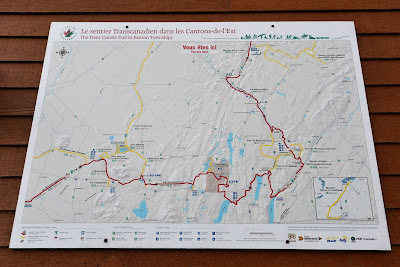

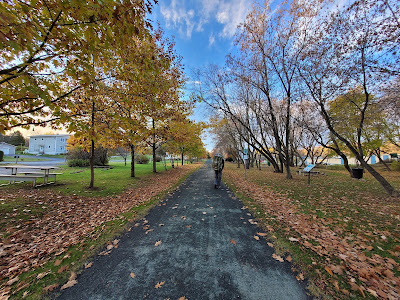

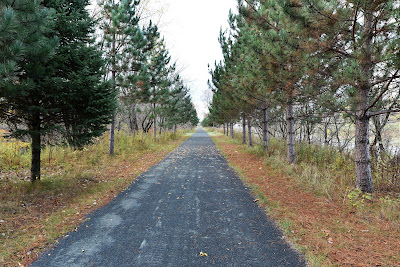


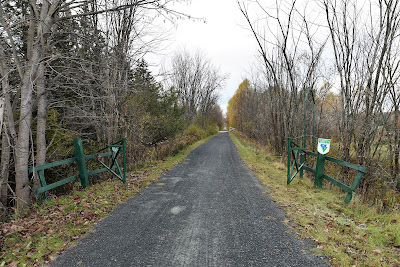


















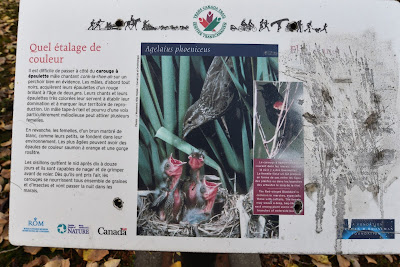
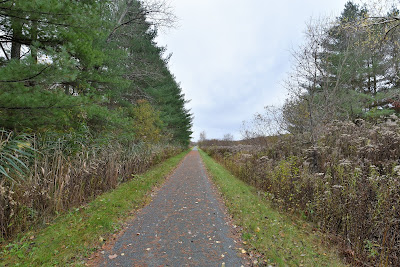

















Comments
Post a Comment